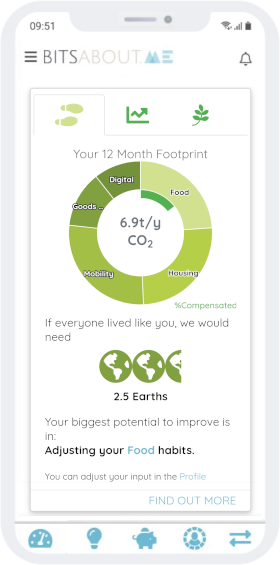It is often difficult to assess the personal impact on the climate. What is my carbon footprint? In which areas can I (still) improve? With the CO2 calculator on BitsaboutMe, you can find out at any time how climate-friendly your lifestyle and consumption behavior are – based on real data from your online accounts! Here you will learn step by step how to get the most out of your CO2 calculator.
CO2 calculator: how to get the most out of it
To fight the climate crisis, we all need to cut emissions. Your carbon footprint is a measure of your personal impact on climate change. Even though these calculations are never exact, you can roughly see where you stand compared to others, and how your behavior is changing over time, hopefully reducing your footprint over time.
To get a rough estimate of your annual CO2 emissions, start with a short survey. There we ask for information about your household, electricity consumption, consumption and eating habits and mobility behavior. These answers will initially serve as rough averages and will be stored in your profile, where you can correct them at any time if necessary.
The unique thing about our CO2 calculator is that you can also use real data from your online accounts to calculate your carbon footprint. The best indicator of CO2 consumption is your spending. By linking your bank accounts in the section My Data, you can estimate your CO2 emissions individually. The model for this calculation comes from our partner South Pole, one of the leading providers of climate protection solutions. As always, your data remains private during these calculations and is not shared with third parties at any time.
When you first connect your bank accounts, the last three months of spending are imported, and then automatically updated each time you log in to BitsaboutMe. Based on categories your bank assigns to different retailer or stores, we calculate the carbon footprint of each payment you make with your debit or credit card. For example, if you bought groceries, the transaction is assigned to the category Food & Beverages. This has less of an impact on CO2 than if you paid the same amount for fuel. Each category has a different factor that gives an average of how much CO2 is emitted per euro or Swiss franc. In the end, the CO2 amount of your purchase is calculated based on the category and the amount you pay. In the section Finance you get an overview of your bank data with all details, where you also have the possibility to exclude certain accounts or transactions from the analysis or to delete them completely. Depending on the retailer or store, it may also happen that your purchase was not assigned to a category or was assigned to the wrong category. In this case, you can assign those expenses to the appropriate category yourself in the detailed view under Finances > Banks.
By the way: the more online accounts you connect and the better your expenses are categorized, the more meaningful the results of your carbon footprint will be! Then the annual averages from the survey or general averages in the areas of Food, Goods and Services, Digital and Mobility are replaced by daily updated information from your bank accounts. Additionally, you can connect your Google account to import, for example, your mobility data, browser history and search queries to further refine the calculation. Your streaming activities from YouTube, Netflix and Spotify also provide an even more accurate picture of your carbon footprint. We always use the best and most specific data available to calculate the best possible footprint.
Make better choices for the climate
Drive to work by car or take the bike instead? Watch Netflix or buy a new book? You can only reduce your carbon footprint if you understand it.
That is why we show you your 12-month footprint at a glance in the Insights. You will not only see how many tons of CO2 you emit per year in each area, but also what these figures are based on and where you have the greatest potential to improve.



On BitsaboutMe you can now calculate your individual carbon footprint based on bank data
The development of your CO2 consumption over time is illustrated on a second graph. You can see how much CO2 you have produced in the past 12 weeks. In addition, you can track the cumulative increase over the last 12 months and see how you compare to the EU average (7 tons of CO2 per year) and to the “sustainable” footprint (2 tons of CO2 per year).
And you even have the option to offset parts of your emissions directly via BitsaboutMe. With the money you earned by sharing your data on the marketplace, you can also buy CO2 certificates from South Pole. Thus, your digital footprint can help reduce or even completely offset your carbon footprint.
Want to try it out yourself? Sign up now on BitsaboutMe and follow the description under Sustainability.